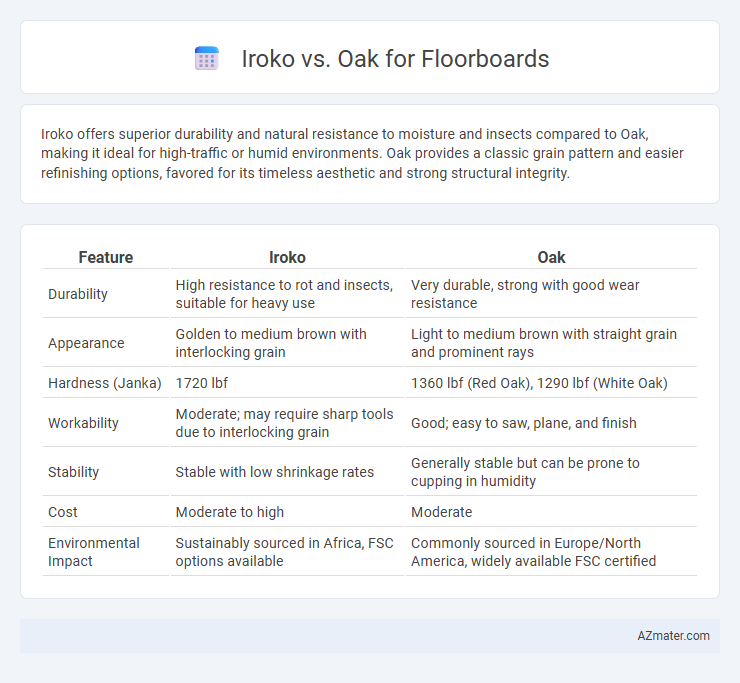Iroko offers superior durability and natural resistance to moisture and insects compared to Oak, making it ideal for high-traffic or humid environments. Oak provides a classic grain pattern and easier refinishing options, favored for its timeless aesthetic and strong structural integrity.
Table of Comparison
| Feature | Iroko | Oak |
|---|---|---|
| Durability | High resistance to rot and insects, suitable for heavy use | Very durable, strong with good wear resistance |
| Appearance | Golden to medium brown with interlocking grain | Light to medium brown with straight grain and prominent rays |
| Hardness (Janka) | 1720 lbf | 1360 lbf (Red Oak), 1290 lbf (White Oak) |
| Workability | Moderate; may require sharp tools due to interlocking grain | Good; easy to saw, plane, and finish |
| Stability | Stable with low shrinkage rates | Generally stable but can be prone to cupping in humidity |
| Cost | Moderate to high | Moderate |
| Environmental Impact | Sustainably sourced in Africa, FSC options available | Commonly sourced in Europe/North America, widely available FSC certified |
Introduction to Iroko and Oak Flooring
Iroko and oak are popular hardwood choices for floorboards with distinct characteristics; Iroko, often called African teak, boasts rich golden to medium brown hues and exceptional durability, making it resistant to moisture and pests. Oak flooring, primarily available as red or white oak, is celebrated for its classic grain patterns, hardness, and versatility in both traditional and modern interiors. Both woods provide long-lasting flooring solutions but differ in appearance, maintenance requirements, and regional availability.
Origin and Characteristics of Iroko Wood
Iroko wood, native to West Africa, is known for its durability and resistance to moisture, making it ideal for floorboards in both indoor and outdoor settings. Its golden to medium brown color with interlocked grain patterns enhances its aesthetic appeal, while its high natural oil content provides excellent resistance to insect attacks and decay. Compared to oak, Iroko offers superior weather resistance and a unique tropical appearance, making it a preferred choice in humid or coastal environments.
Key Features of Oak Wood Floorboards
Oak wood floorboards are prized for their exceptional durability, dense grain structure, and natural resistance to wear and dents, making them ideal for high-traffic areas. Their distinctive grain patterns and warm, rich tones provide a timeless aesthetic that enhances the value and appeal of any interior space. Oak's versatility in finishes and stains allows for customization, while its high stability ensures minimal warping or splitting over time.
Appearance and Color Comparison
Iroko floorboards showcase a rich golden to medium brown hue with occasional dark streaks, creating a warm and exotic appearance that deepens with age. Oak floorboards offer a lighter, more neutral palette ranging from pale creamy tones to light reddish-brown shades, providing a classic and versatile look. The natural grain in oak tends to be more pronounced and uniform, while iroko's texture is interlocked and slightly coarse, adding unique character to flooring designs.
Durability and Hardness
Iroko and oak are both popular hardwood choices for floorboards, with Iroko boasting Janka hardness ratings around 1,260 lbf and oak ranging between 1,200 and 1,360 lbf depending on species. Iroko is prized for its exceptional durability, natural resistance to rot and insect attack, and its stability in varying humidity, making it ideal for high-traffic areas. Oak offers strong wear resistance, excellent hardness, and a classic grain pattern but may require more maintenance to prevent moisture damage compared to Iroko.
Cost and Affordability
Iroko floorboards typically cost more than oak due to their durability and resistance to moisture, making them a premium choice for long-lasting flooring. Oak remains a popular, more affordable option with a wide availability, offering a classic look at a lower initial investment. Budget-conscious homeowners often prefer oak for cost efficiency, while those prioritizing durability might find Iroko worth the higher price.
Environmental Impact and Sustainability
Iroko wood, sourced primarily from West Africa, offers a more sustainable option compared to Oak due to its faster growth rate and better carbon sequestration during cultivation. Oak, often harvested from temperate forests, risks contributing to deforestation and habitat loss if not managed through certified sustainable forestry practices. Choosing FSC-certified Iroko or Oak ensures lower environmental impact and promotes responsible forestry management.
Maintenance and Longevity
Iroko floorboards offer high durability and natural resistance to moisture and insects, requiring minimal maintenance such as occasional cleaning and periodic oiling, which enhances their lifespan of up to 25-30 years. Oak floorboards, while harder and more resistant to wear, demand regular sealing and refinishing to prevent moisture damage and maintain their rich appearance, typically lasting 20-35 years with proper care. Both woods provide excellent longevity, but Iroko's natural oils make it more low-maintenance, whereas Oak requires more consistent upkeep to preserve its durability and aesthetic appeal.
Suitability for Different Interior Styles
Iroko's warm golden-brown hues and natural grain patterns complement rustic, traditional, and tropical interiors, enhancing spaces with an exotic, natural feel. Oak's versatile light to medium tones and fine, consistent grain make it ideal for modern, Scandinavian, and minimalist styles, providing a clean, timeless look. Both woods offer durability, but Iroko's richer color and hardness suit bold, characterful designs, while oak's neutrality adapts seamlessly to varied decor themes.
Which is Better for Your Floorboard: Iroko or Oak?
Iroko offers superior durability and natural resistance to moisture, making it an excellent choice for high-traffic or humid areas compared to oak, which, while aesthetically pleasing with its warm grain patterns, is softer and more prone to dents. Oak floors tend to be more cost-effective and offer a timeless look with easy refinishing options, whereas iroko's dense fibers provide enhanced stability and longevity, especially in challenging environments. Choosing between iroko and oak depends largely on your floorboard's location, maintenance preferences, and desired lifespan, with iroko excelling in durability and oak favored for traditional charm and affordability.

Infographic: Iroko vs Oak for Floorboard
 azmater.com
azmater.com